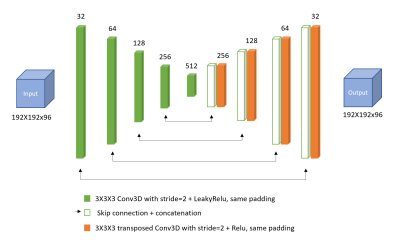Oriana Vanesa Arsenov1, Karin Shmueli1, and Anita Karsa1
1Medical Physics and Biomedical Engineering, University College London, London, United Kingdom
1Medical Physics and Biomedical Engineering, University College London, London, United Kingdom
We trained a deep-learning network
for background field removal using random spatial deformations to simulate
realistic fields (Model 1) and to augment field maps measured in vivo (Model
2). Model 1 predicts local fields better for synthetic vs in-vivo images. Model
2 performed better in vivo.

Figure 1. The architecture of the 3D U-net used for Background field removal
(BGFR). The convolutional neural network (CNN) displays the output local field
maps (Bint) the same size (192x192x96) as the input total field maps
(Btot) . The number of feature maps is shown on top of each of the
network’s layers.

Figure 2. A set of training field maps inside the brain simulated in a head
and neck phantom with random deformations. A sagittal and a coronal slice of
the total Btot (a), background Bext (b), and local Bint (c) field maps. The
local fields are equal to the total fields minus the background fields: Bint
= Btot - Bext.